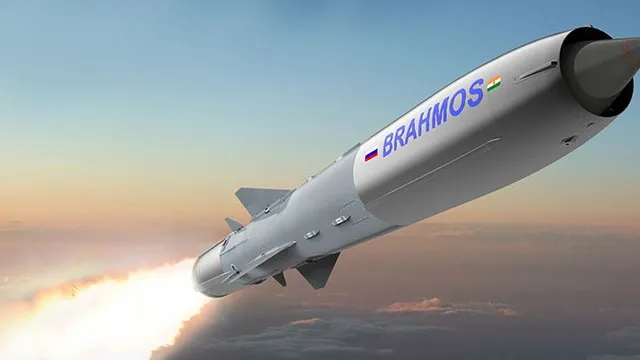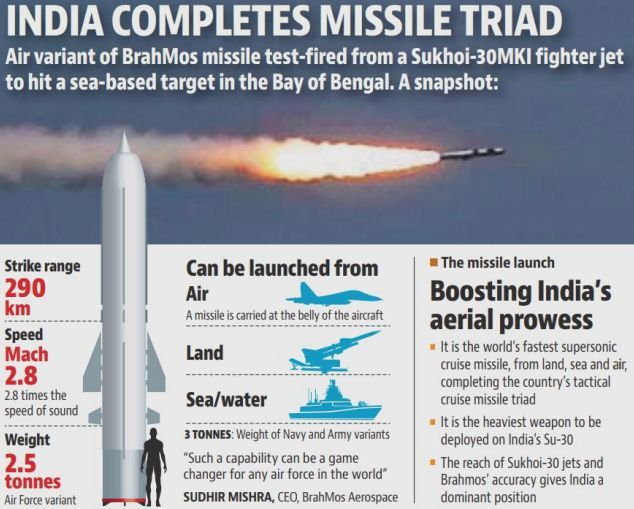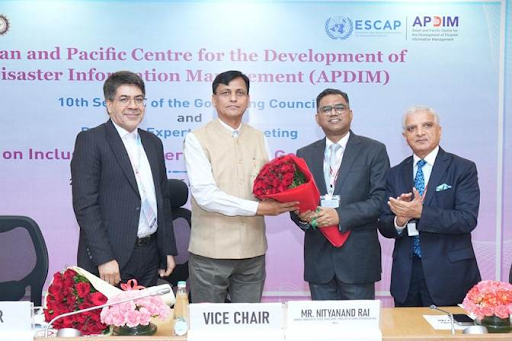Description

Disclaimer: Copyright infringement is not intended.
Context:
- India’s BrahMos supersonic cruise missiles were delivered to the Philippines as part of a $375 million deal signed by the two countries in 2022.
BrahMos missile
- The need for the BrahMos missile system emerged following the Gulf War in 1991, which highlighted the efficacy of such weapons.
- In 1998, BrahMos Aerospace was formed as a part of intergovernmental agreement between India and Russia, for developing the Missile.
Strategic Significance Brahmos Missile:
- Two-Stage Design: BrahMos is a two-stage missile with a solid propellant booster engine, enabling it to achieve supersonic speeds and deliver payloads with high precision over long distances.
- Stealth features: The missile has a low radar signature, making it difficult to detect, and can operate at various altitudes and trajectories.
- Improved efficiency: It can strike targets with extreme accuracy, enhancing its effectiveness in diverse combat scenarios.
- Standoff Range Capability: BrahMos is a "standoff range weapon," which means that it can be launched from a distance far enough to evade enemy defenses, increasing its survivability and lethality.
- Export Potential: The export of BrahMos to other countries enhances India's defense diplomacy and contributes to its image as an arms exporter.
Variants of Brahmos:
BrahMos is deployed across land, sea, and air platforms, forming a triad of capabilities that bolster India's defense posture.
- Land-Based: Mobile autonomous launchers along India's borders provide flexibility and strategic depth in defense operations.
- Ship-Based: BrahMos-equipped warships extend India's maritime reach, capable of engaging both sea and land targets.
- Air-Launched: Integration with Sukhoi-30MKI aircraft enhances India's aerial strike capabilities, providing a deterrent against adversaries.
- Submarine-Launched: The submarine-launched version adds a stealthy and potent dimension to India's naval capabilities, enabling underwater strikes with precision.

BrahMos missile exports and discussions with various countries:
- Philippines: BrahMos missiles were delivered to the Philippines as part of a deal signed in 2022.
- Vietnam: Discussions regarding BrahMos missile sales to Vietnam have been ongoing in recent years.
- UAE (United Arab Emirates): Talks about the possible export of BrahMos missiles to the UAE have been reported in recent years, without a specific year of export mentioned.
- Indonesia: Interest from Indonesia in acquiring BrahMos missiles has also been reported from last year..
- Oman: Talks between India and Oman regarding the sale of BrahMos missiles have been reported in the last year.
- Chile: Discussions about the potential sale of BrahMos missiles to Chile have been reported recently.
Future Prospects
- BrahMos continues to undergo enhancements, including increased range, speed, and stealth features. Development efforts are aimed at maintaining its technological edge and expanding its operational capabilities.
Source:
https://indianexpress.com/article/explained/brahmos-missiles-philippines-development-9280055/
|
PRACTICE QUESTION
Q) Consider the following statements:
- Ballistic missiles are jet-propelled at subsonic speeds throughout their flights, while cruise missiles are rocket-powered only in the initial phase of flight.
- Agni-V is a medium-range supersonic cruise missile, while BrahMos is a solid-fuelled intercontinental ballistic missile.
Which of the statements given above is/are correct?
- 1 only
- 2 only
- Both 1 and 2
- Neither 1 nor 2
Answer: (d) Neither 1 nor 2.
Explanation:
Statement 1 is incorrect:
Ballistic missiles are not jet-propelled; they are rocket-powered throughout their flight. They follow a ballistic trajectory, meaning they are propelled into the atmosphere and then travel in a parabolic arc under the influence of gravity. Cruise missiles, on the other hand, are jet-propelled and can maintain powered flight at subsonic or supersonic speeds throughout their journey.
Statement 2 is also incorrect:
Agni-V is not a cruise missile; it is an intercontinental ballistic missile (ICBM). Agni-V is indeed solid-fueled and has a range that qualifies it as an ICBM, capable of reaching targets beyond 5,500 kilometers. BrahMos, on the other hand, is a supersonic cruise missile developed jointly by India and Russia. It is not an ICBM and is not designed for intercontinental ranges. Additionally, BrahMos is not powered by solid fuel; it is powered by a combination of solid and liquid fuels.
Neither statement 1 nor statement 2 is correct, so the correct answer is option (d) Neither 1 nor 2.
|













